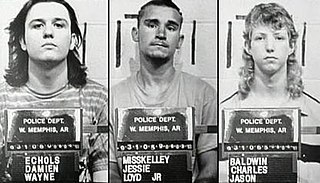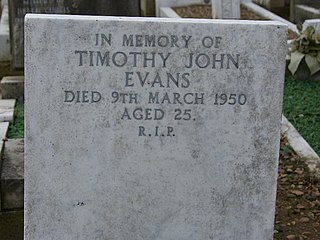
The West Memphis Three are three men convicted as teenagers in 1994 of the 1993 murders of three boys in West Memphis, Arkansas, United States. Damien Echols was sentenced to death, Jessie Misskelley Jr. to life imprisonment plus two 20-year sentences, and Jason Baldwin to life imprisonment. During the trial, the prosecution asserted that the juveniles killed the children as part of a Satanic ritual.
Circumstantial evidence is evidence that relies on an inference to connect it to a conclusion of fact—such as a fingerprint at the scene of a crime. By contrast, direct evidence supports the truth of an assertion directly—i.e., without need for any additional evidence or inference.
Innocence Project, Inc. is a 501(c)(3) nonprofit legal organization that is committed to exonerating individuals who have been wrongly convicted, through the use of DNA testing and working to reform the criminal justice system to prevent future injustice. The group cites various studies estimating that in the United States between 1% and 10% of all prisoners are innocent. The Innocence Project was founded in 1992 by Barry Scheck and Peter Neufeld who gained national attention in the mid-1990s as part of the "Dream Team" of lawyers who formed part of the defense in the O. J. Simpson murder case.

A miscarriage of justice occurs when an unfair outcome occurs in a criminal or civil proceeding, such as the conviction and punishment of a person for a crime they did not commit. Miscarriages are also known as wrongful convictions. Innocent people have sometimes ended up in prison for years before their conviction has eventually been overturned. They may be exonerated if new evidence comes to light or it is determined that the police or prosecutor committed some kind of misconduct at the original trial. In some jurisdictions this leads to the payment of compensation.
Wrongful execution is a miscarriage of justice occurring when an innocent person is put to death by capital punishment. Cases of wrongful execution are cited as an argument by opponents of capital punishment, while proponents say that the argument of innocence concerns the credibility of the justice system as a whole and does not solely undermine the use of the death penalty.
This is a list of notable overturned convictions in the United States.
It is possible to convict someone of murder without the purported victim's body in evidence. However, cases of this type have historically been hard to prove, often forcing the prosecution to rely on circumstantial evidence, and in England there was for centuries a mistaken view that in the absence of a body a killer could not be tried for murder. Developments in forensic science in recent decades have made it more likely that a murder conviction can be obtained even if a body has not been found.

Terry Anthony Blair is an American serial killer who was convicted of killing seven women of various ages in Kansas City, Missouri, though investigators believe he may have additional unidentified victims.
Rolando Cruz is an American man known for having been wrongfully convicted and sentenced to death, along with co-defendant Alejandro Hernandez, for the 1983 kidnapping, rape, and murder of 10-year-old Jeanine Nicarico in DuPage County, Illinois. The police had no substantive physical evidence linking the two men to the crime. Their first trial was jointly in 1987, and their statements were used against each other and a third defendant.
William Jackson "Jack" Marion was an American man who was convicted of the 1872 murder of John Cameron, a Kansas native and a friend. Marion and Cameron were railroad workers who embarked on a trip to Kansas to work on the railroad in 1872. During the trip, Cameron went missing, spurring an investigation into his whereabouts. In 1873, a decomposing body was discovered in a Nebraska riverbed wearing clothing that some claimed to have belonged to Cameron, leading authorities to believe that Marion may have murdered Cameron. Years later, following a two-month trial and conviction, the state of Nebraska executed Marion for Cameron's murder in 1887.
This is a list of notable overturned convictions in Canada.
The Illinois Innocence Project, a member of the national Innocence Project network, is a non-profit legal organization that works to exonerate wrongfully convicted people and reform the criminal justice system to prevent future injustice.

The California Innocence Project is a non-profit based at California Western School of Law in San Diego, California, United States, which provides pro bono legal services to individuals who maintain their factual innocence of crime(s) for which they have been convicted. It is an independent chapter of the Innocence Project. Its mission is to exonerate wrongly convicted inmates through the use of DNA and other evidences.

Ryan W. Ferguson is an American man who spent nearly 10 years in prison after being wrongfully convicted of a 2001 murder in his hometown of Columbia, Missouri. At the time of the murder, Ferguson was a 17-year-old high-school student.

Investigating Innocence is a nonprofit wrongful conviction advocacy organization that provides criminal defense investigations for inmates in the United States. Investigating Innocence was founded in 2013 by private investigator Bill Clutter to assist nationwide Innocence Project groups in investigating innocence claims. "Once we have a case that meets our criteria, we'll put private investigators to work on it. A lot of these cases need investigators," said Kelly Thompson, executive director of Investigating Innocence. Prior to his work on Investigating Innocence, Clutter was one of the founders of the Illinois Innocence Project. Investigating Innocence also has a board composed of exonerees that reviews incoming cases.

Louis N. Scarcella is a retired detective from the New York City Police Department (NYPD) who initially came to prominence during the "crack epidemic" of the 1980s and 1990s, earning frequent commendations before many convictions resulting from his investigations were overturned during his retirement. As a member of the Brooklyn North Homicide Squad, he and his longtime partner Stephen Chmil built a reputation for obtaining convictions in difficult cases. Since 2013, Scarcella has received extensive and sustained publicity for multiple allegations of investigative misconduct that resulted in false testimony against crime suspects, meaning that innocent parties could have served long prison terms and guilty individuals could have gone free because of wrongful procedures.
The Ford Heights Four were formerly imprisoned convicts, who were falsely accused and convicted of the double murder of Lawrence Lionberg and Carol Schmal in Ford Heights, Illinois, and later exonerated. Jimerson and Williams were sentenced to death, Adams to 75 years in prison and Rainge to life. Following the murder in 1978, the four spent almost two decades in prison before being released in 1996. This miscarriage of justice was due to false forensic testimony, coercion of a prosecution witness, perjury by another witness who had an incentive to lie, and prosecution and police misconduct. The DNA evidence uncovered in the investigation to clear their names eventually led to the arrest and conviction of the real killers.
Columbus Lee Harkins (1864–July, 30, 1920) was an American veterinary surgeon, serial child rapist, and suspected mass murderer.
Kevin Strickland is an African-American man who was wrongfully convicted by an all-white jury in 1979 of killing three people in Kansas City, Missouri. No physical evidence linked him to the scene of the crime and the only alleged witness later recanted her testimony that Strickland was involved. Strickland was given a life sentence. In 2021, he garnered national attention after former prosecutors in his case said that he was very likely innocent and called for his release.





